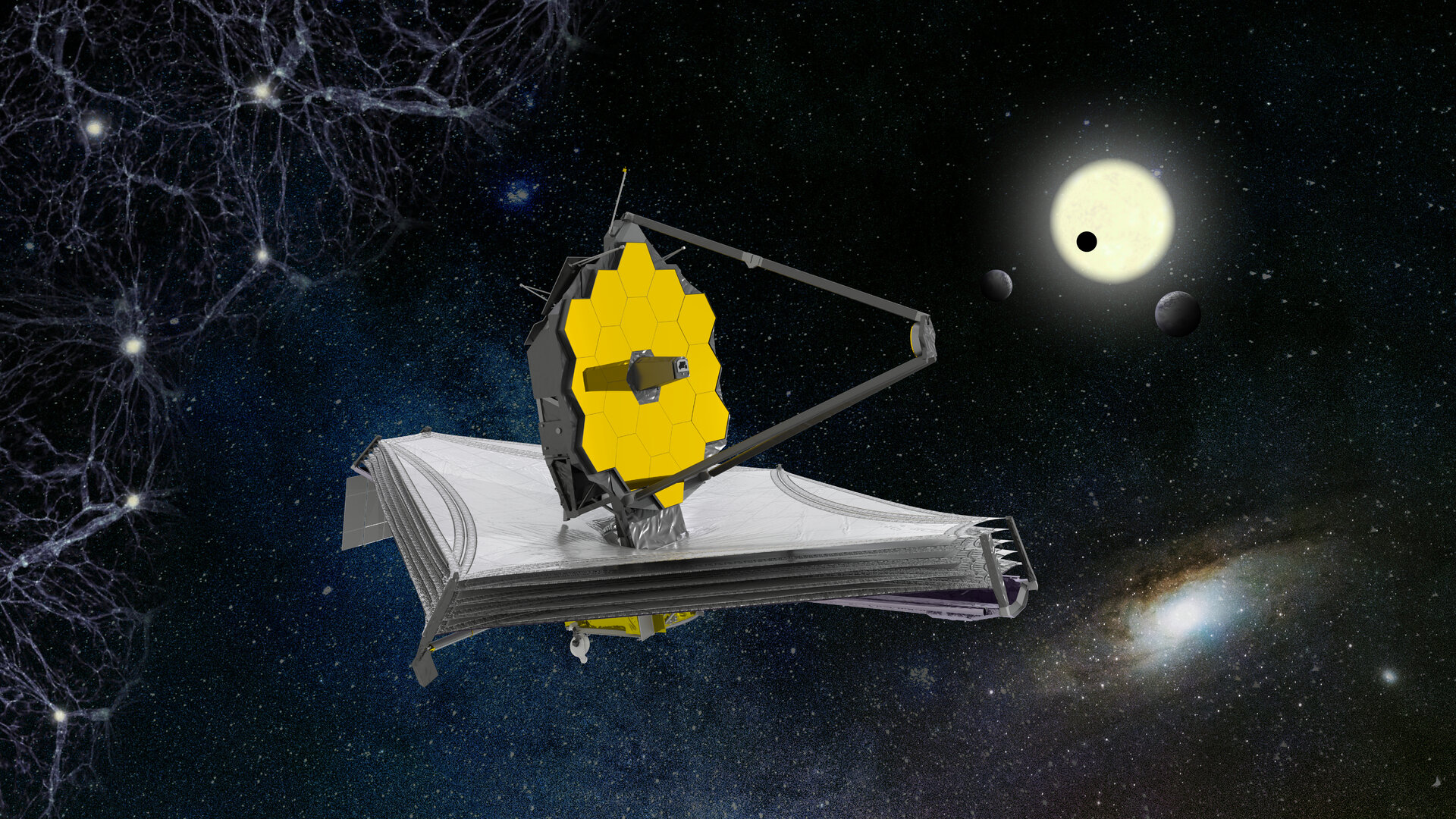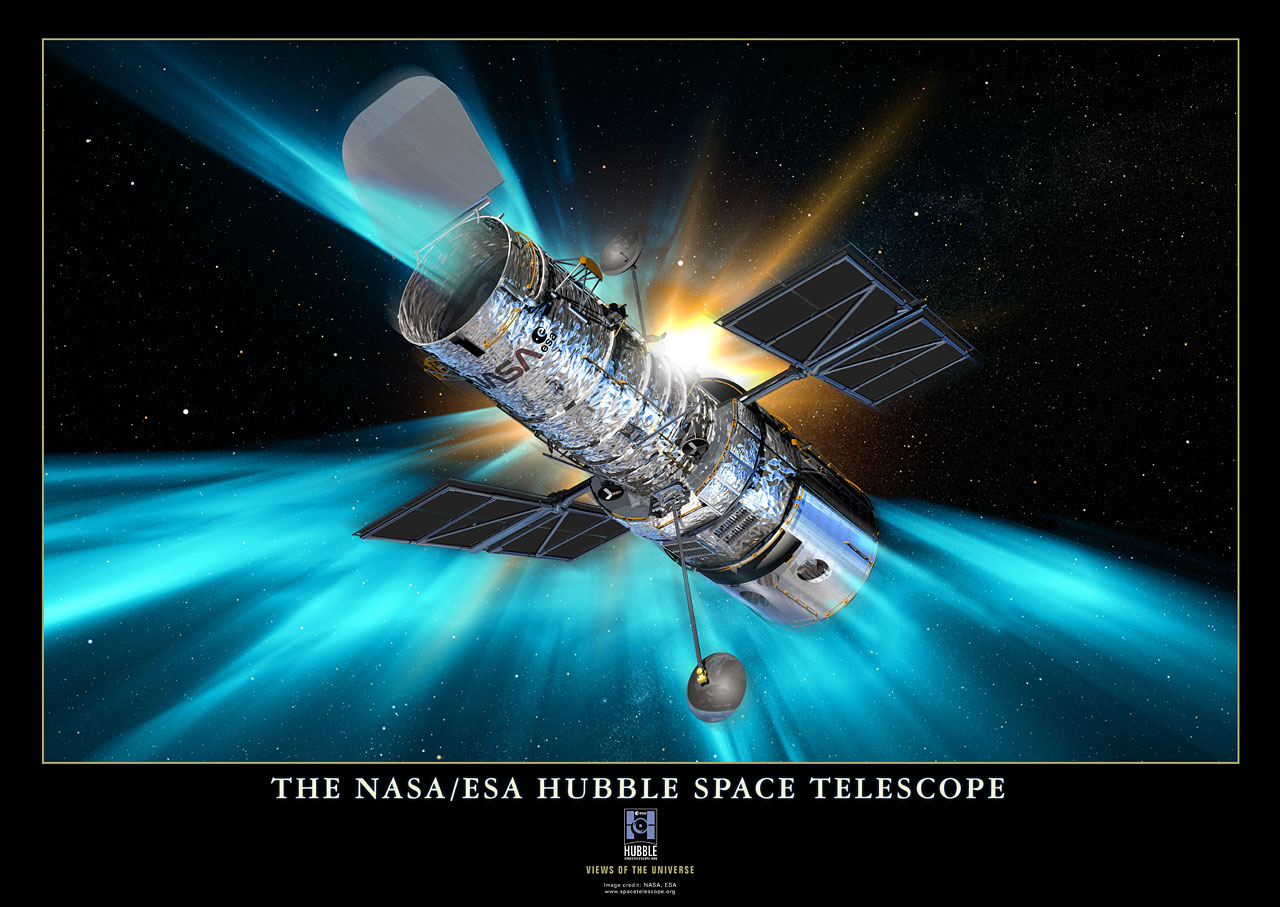Stardust and Eternity – 3.5.3
Space-Based Telescopes
Space-based telescopes are located beyond the Earth, in outer space, in orbit around the planet or in deep space. Space telescopes have several advantages over ground-based telescopes. Astronomy performed from ground-based observatories on Earth is limited by the filtering and distortion of light (scintillation or twinkling) due to the atmosphere. A telescope orbiting the Earth, outside the atmosphere, is subject neither to twinkling nor to light pollution from artificial light sources on Earth. The angular resolution of space telescopes is therefore often much higher than that of ground-based telescopes with similar aperture, although nowadays many large ground-based telescopes can reduce atmospheric effects with adaptive optics. Indeed, space-based astronomy is most important for frequency ranges outside the optical window and the radio window, the only two wavelength ranges of the electromagnetic spectrum that are not severely attenuated by the atmosphere. For instance, astronomy of UV and X-rays is almost impossible when carried out from Earth, as these short-wavelength radiations are almost totally blocked by the Earth’s atmosphere and never reach the surface. Another important advantage is that telescopes in space are able to operate 24 hours a day, free from Earth’s day-night cycle, clouds and other limiting weather conditions.
Space telescopes also have some disadvantages. Their most obvious one is that they are much more expensive than ground-based telescopes, not to mention the high launch costs, and they are also extremely difficult to maintain, since they operate fully automatically, without humans on site to fix faulty equipment or deal with other problems. There are also major limitations on the size and mass of telescopes that can be launched, as well as the need to use special materials and designs that can withstand the extreme environment of space.
The rush to build space telescopes began in the 1960s, when astronomers started attaching balloons to telescopes as a means of taking them above the Earth’s atmosphere to obtain a sharper view of astronomical objects. The Hubble Space Telescope – launched by the space shuttle Discovery in 1990 and still operative today – is the most famous of the space observatories; however, it is just one of many that have provided astronomers with new insights into the universe. The James Webb Space Telescope (JWST), launched in 2021 by the European Space Agency (ESA), is the most powerful telescope ever launched into space, with a 6.5 m primary mirror and designed mainly for infrared astronomy. The JWST can also detect orange and red light; its improved resolution and sensitivity will allow it observe objects that are too old, distant or faint for the Hubble Space Telescope, allowing it provide detailed atmospheric characterisation of potentially habitable exoplanets.


Further Resources
Links below will redirect you to external websites. In accordance with the European data protection declarations, we would like to point out that by clicking on these links you may send data to external providers. We cannot prevent that.
Images
![]() Transparency of the atmosphere (ESA/Hubble, F. Granato)
Transparency of the atmosphere (ESA/Hubble, F. Granato)
![]() Wavelength sensitivity of current and future space- and ground-based observatories (NASA, STScI)
Wavelength sensitivity of current and future space- and ground-based observatories (NASA, STScI)
![]() The Hubble Space Telescope (European Space Agency)
The Hubble Space Telescope (European Space Agency)
![]() Telescope Primary Mirror Sizes Compared (NASA, ESA, STScI)
Telescope Primary Mirror Sizes Compared (NASA, ESA, STScI)
![]() About Spectroscopy (NASA, ESA, CSA, Stephanie Smith (STScI), Christine Klicka Godfrey (STScI)
About Spectroscopy (NASA, ESA, CSA, Stephanie Smith (STScI), Christine Klicka Godfrey (STScI)
![]() The Electromagnetic Spectrum (with Hubble, Webb, and Spitzer Highlights) (NASA and J. Olmsted (STScI)
The Electromagnetic Spectrum (with Hubble, Webb, and Spitzer Highlights) (NASA and J. Olmsted (STScI)
![]() Webb in Orbit at Sun-Earth L2 (NASA, STScI)
Webb in Orbit at Sun-Earth L2 (NASA, STScI)
Videos
![]() A Battle Of Giants – Telescopes In Space And On The Ground
A Battle Of Giants – Telescopes In Space And On The Ground
![]() How The Largest Space Telescope Compare With The Largest Ground Based Telescope (JWST vs E-ELT)
How The Largest Space Telescope Compare With The Largest Ground Based Telescope (JWST vs E-ELT)
![]() Why do we need telescopes in space?
Why do we need telescopes in space?
![]() How NASA’s Webb Telescope Will Transform Our Place in the Universe
How NASA’s Webb Telescope Will Transform Our Place in the Universe
![]() 30 Years of Science with the Hubble Space Telescope
30 Years of Science with the Hubble Space Telescope
 Telescopi spaziali X e gamma per studiare l’universo estremo (MEDIAINAF TV)
Telescopi spaziali X e gamma per studiare l’universo estremo (MEDIAINAF TV)
 JAMES WEBB E HUBBLE : UN CONFRONTO TRA I GIGANTI TELESCOPI SPAZIALI (Spazio Zona)
JAMES WEBB E HUBBLE : UN CONFRONTO TRA I GIGANTI TELESCOPI SPAZIALI (Spazio Zona)
 Cosa mostrano realmente le prime immagini del telescopio spaziale James Webb (Geopop)
Cosa mostrano realmente le prime immagini del telescopio spaziale James Webb (Geopop)
 Come sono fatte le immagini del telescopio spaziale Hubble (MEDIAINAF TV)
Come sono fatte le immagini del telescopio spaziale Hubble (MEDIAINAF TV)
Online Resources
![]() The James Webb Space Telescope
The James Webb Space Telescope
 Hubble Space Telescope: storia e scoperte di uno strumento rivoluzionario per l’astronomia (Geopop)
Hubble Space Telescope: storia e scoperte di uno strumento rivoluzionario per l’astronomia (Geopop)
 Hubble, storia di un occhio spalancato sul cosmo (Focus)
Hubble, storia di un occhio spalancato sul cosmo (Focus)
 Il telescopio James Webb ha visto la galassia più antica di sempre (Focus)
Il telescopio James Webb ha visto la galassia più antica di sempre (Focus)
Further Readings
![]() Eyes on the Sky: A Spectrum of Telescopes (Francis Graham-Smith)
Eyes on the Sky: A Spectrum of Telescopes (Francis Graham-Smith)
![]() Surveying the Skies: How Astronomers Map the Universe (Gareth Wynn-Williams)
Surveying the Skies: How Astronomers Map the Universe (Gareth Wynn-Williams)
![]() Spacecraft for Astronomy (Joseph A. Angelo)
Spacecraft for Astronomy (Joseph A. Angelo)
 Dal vicino al medio infrarosso: tutti i colori di Jwst (Claudia Mignone)
Dal vicino al medio infrarosso: tutti i colori di Jwst (Claudia Mignone)
 Webb trova acqua su una cometa vicina a casa (Maura Sandri)
Webb trova acqua su una cometa vicina a casa (Maura Sandri)
 Satelliti artificiali rovinano le immagini di Hubble (Valentina Guglielmo)
Satelliti artificiali rovinano le immagini di Hubble (Valentina Guglielmo)
Teaching Material
![]() ESA kids resources (ESA)
ESA kids resources (ESA)
For Kids
![]() How Hubble Works (Spaced Out)
How Hubble Works (Spaced Out)
![]() What is Hubble? (Spaced Out)
What is Hubble? (Spaced Out)
![]() Paxy – ESA kids Mascotte (ESA)
Paxy – ESA kids Mascotte (ESA)
 Il telescopio spaziale James Webb rivela il cosmo come mai prima d’ora! (ESA – Space for Kids)
Il telescopio spaziale James Webb rivela il cosmo come mai prima d’ora! (ESA – Space for Kids)
 Webb vs. Hubble: le immagini dell’universo a confronto (Focus Junior)
Webb vs. Hubble: le immagini dell’universo a confronto (Focus Junior)
